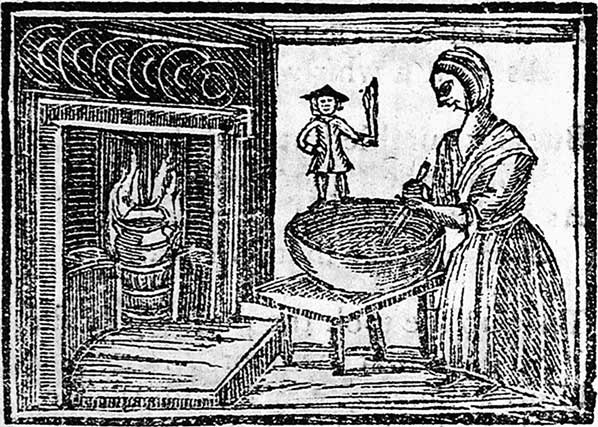|
England is swamped in folktales about tiny people – fairies, elves, brownies. However, they only have one thumbling tale that I've found. Most places have multiple variants of the thumbling tale. England is small, but even individual small regions of France and Spain have recorded more than one unique variant. Ireland has quite a few too. I know of two variants from Scotland, Tómas na h òrdaig and Comhaoise Ordaig. But in England, there’s only Tom Thumb. There are a couple of songs that hint at similar stories (see "I Had a Little Husband") but sadly, England's amount of recorded folklore is much lower than that of its neighbors. SurLaLune does list one tale from Derbyshire under Thumbling tales: Dathera Dad. This is a very short tale. A woman is cooking, when the pudding begins to shake and jump around. Frightened, she gives it to a passing tinker to get rid of it. It continues to shake, and finaly breaks apart to reveal a tiny fairy child who runs away crying, "Take me to my dathera dad." This initially seems like just another tale of a tiny fairy, not a type 700 tale. However, the incident is identical to Tom Thumb's adventure in a pudding. The pudding incident was also Tom Thumb's most famous and recognizable feat around the 1600s. He was frequently shown falling into the bowl. In the 1611 Coryat’s Crudities, ten years before the first known printed version of the tale, "Tom Thumbe is dumbe, untill the pudding creepe, in which he was intomb'd, then out doth peepe." In 1625, Ben Jonson’s masque, The Fortunate Isles, mentions "Thomas Thumb in a pudding fat." In 1653, the Lady Margaret Newcastle's "Pastimes of the Fairy Queen" mentioned Tom Thumb "who doth like peice of fat in pudding lye."
"Can I bear to see him from a Pudding mount the throne?" a character asks in the parodic play "Tragedy of Tragedies; Or the Life and Death of Tom Thumb the Great." This is not the same kind of pudding I eat. As an American, the puddings I know would splash rather than break! The original puddings were baked, steamed or boiled and were a primary dish in the everyday diet. They could be made of meat, blood, batter and other ingredients, and formed a solid mass that had to be sliced or broken, as in Dathera Dad. Sidney Oldall Addy theorizes that "dathera" comes from the Icelandic daðra, to wheedle. According to the English Dialect Dictionary, “dather” is to shiver, tremble, or shake with cold or age, and "dathered" can mean bewildered or withered. Dathera Dad is an example of the Runaway Pancake tale, but it's a little different. Most of these versions feature the food actually coming to life and running away; Dathera Dad is a tale of a supernatural being trapped inside the food. The most similar example on that page is a Russian tale called "The Devil in the Dough Pan." Once a woman was kneading bread, but had forgotten to say the blessing. So the demon, Potánka, ran up and sat down in it. Then she recollected she had kneaded the dough without saying the blessing, went up to it and crossed herself; and Potánka wanted to escape, but could not anyhow, because of the blessing. So she put the leavened dough through a strainer and threw it out into the street, with Potánka inside. The pigs turned him over and over, and he could not escape for three whole days. At last he tore his way out through a crack in the dough and scampered off without looking behind him. He ran up to his comrades, who asked him, " Where have you been, Potánka?" "May that woman be accursed!" he said. "Who?" "The one who was kneading her dough and had made it without saying the proper blessing; so I ran up and squatted in it. Then she laid hold of me and crossed herself, and after three livelong days I got out, the pigs poking me about and I unable to escape! Never again will I get into a woman's dough." It's interesting that in these cases the thing inside the food is a fairy or evil spirit. In the Metrical History of Tom Thumb the Little, there's a line regarding this scene: "But so it tumbled up and down, Within the liquor there, As if the devil had been boil'd." In the 1584 Discoverie of Witchcraft, "Tom thombe" is included among a list of monsters and demons. Come to think of it, The Gingerbread Man - probably the most famous version of the Runaway Pancake - has a lot in common with Tom Thumb. He's created after an elderly couple wishes for a child, and his story revolves around being eaten. More on Pudding Text copyright © Writing in Margins, All Rights Reserved
0 Comments
Leave a Reply. |
About
Researching folktales and fairies, with a focus on common tale types. Archives
July 2024
Categories
All
|
Writing in Margins

 RSS Feed
RSS Feed
